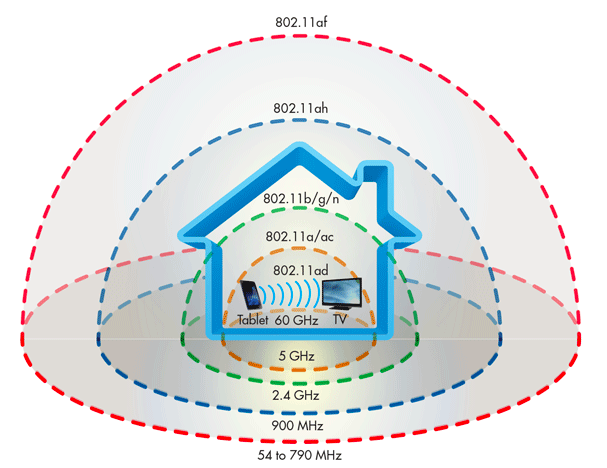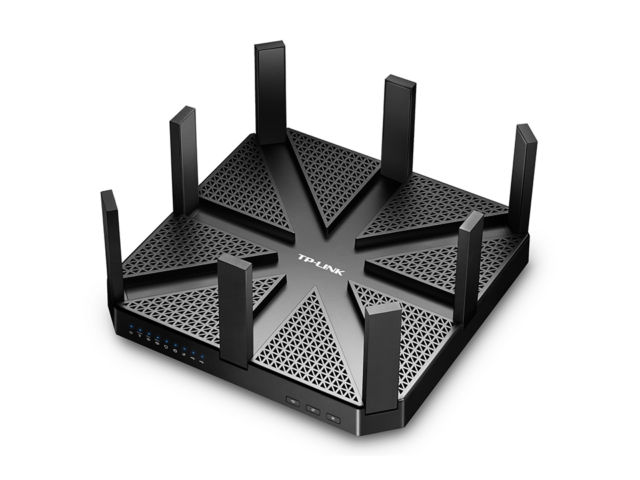The former WiGig 60GHz standard is finally here, but can it live up to the hype?
There’s a new Wi-Fi standard in town, and it takes speed to another level. 802.11ad Wi-Fi is rated for data throughput up to 4,600Mbps, or four times faster than the current speed champ 802.11ac. That’s much faster than standard gigabit Ethernet and most home broadband speeds, although—as any Wi-Fi user knows—there’s a big difference between theoretical speed and what’s possible in practice. Still, want to stream high-bitrate 4K, HDR films over Wi-Fi? That won’t be a problem with 802.11ad. Even the best triple-layer UHD Blu-rays top out at 128Mbps bitrates. There’s even a chance it could make high-end wireless virtual reality headsets more practical.
802.11ad will at first be available via a new wave of home routers, a couple of which have already hit the shelves: the Netgear Nighthawk X10 and the TP-Link Talon AD7200. As ever with brand-new tech, the routers demand a hefty premium, with the AD7200 costing an eye-watering £350/$360—that’s as much as even sophisticated mesh-based systems like the Ubiquiti Amplifi. Is 802.11ad Wi-Fi worth the cost? Is there anything you can even reasonably use it for right now? Or should you hold out for the inevitable price drops? Let’s find out.
How does 802.11ad Wi-Fi work?
Like previous versions of Wi-Fi, 802.11ad is an official standard ratified by the Wi-Fi Alliance. Unlike previous versions, however, the tech behind it didn’t come from the IEEE (Institute of Electrical and Electronics Engineers). Instead, it’s based on tech created by the WiGig (Wireless Gigabit) Alliance, which was officially announced back in 2009, entered draft stage with the IEEE in 2011, and finally emerged as the standard it is today when the WiGig Alliance merged with Wi-Fi Alliance in 2013.
Knowing all this isn’t very important for consumers (even if it does go to show that once you get a committee involved, things take a long time), but it does explain why 802.11ad is so different to its predecessors. The key to the new standard is that it uses a completely different frequency band to previous Wi-Fi standards. Instead of using the 2.4GHz or 5GHz frequencies of 802.11b/g/n/ac, it works over 60GHz—technically, between 57 and 66GHz, depending on what part of the world you live in. The large chunks of spectrum available at around 60GHz mean far more data can be transmitted, but there are some downsides.

An illustrative example of Wi-Fi range in a typical home.
The biggest problem is that, as a general rule, the higher the frequency or the shorter the wavelength, the greater the absorption rate. That’s not a problem in a vacuum, but in the real world where we have wooden floors and brick walls, high-frequency waves have trouble travelling long distances. That’s why long wavelength (i.e. low frequency) signals like radio and television can travel vast distances, while short-wavelength signals such as visible light are absorbed by most materials.
When it comes to Wi-Fi, all of its frequencies fall into the microwave category that spans 300MHz up to 300GHz, with wavelengths of around 1 metre to 1 millimetre respectively. The 2.4GHz of older Wi-Fi standards a/b/g is low enough that it has good penetrative power, and can quite happily pass through people, doors, and walls. The move to the 5GHz frequency for 802.11n/ac did actually reduce the useable range, which is why many routers support both 2.4GHz and 5GHz networks (as well as for backwards compatibility), but on the whole 5GHz remains largely useable throughout small homes.
With 802.11ad, though, the signals can’t even penetrate a single brick wall, and are greatly impacted by a simple wooden door. As a result, while 802.11ad provides very fast speeds if you’re in the same room as your router, step outside that room—or even out of line of sight of the router—and you lose signal.
This is why 802.11ad isn’t a replacement for existing Wi-Fi standards. Instead, just like 5GHz routers always include support for 2.4GHz, there will usually be an older standard included in 802.11ad 60GHz routers and client devices so that they can still be used at long range.
Cable replacement
802.11ad can also be used as a cable replacement technology—and indeed, that’s how WiGig was originally conceived. 802.11ad could eventually see products like TVs, set-top boxes, smartphones, or even cameras wirelessly deliver and receive UHD video, while NAS boxes and portable hard drives could use it to back up data quickly and wirelessly. 802.11ad could even be used to replace the DisplayPort on your monitor.
The idea is that, for the living room at least, you can have an entirely cable-free setup—at least with regards to data cables. While wireless power is now available, it’s not yet at the point where you can power a TV with it.
This also extends to office and other PC environments where wireless laptop docks, monitor connections, and more could be replicated with this technology. Dell was one of the first to adopt WiGig in 2013, creating the Dell Wireless Dock D5000, which allowed users to transmit video from a Latitude laptop to the dock and out over a HDMI connection.
That utopian vision of a wireless future is some ways off, but it shows how the technology could be used in the future.
Elsewhere, the new standard delivers very little in terms of new features such as beamforming or MU-MIMO. It essentially uses the same techniques introduced with previous standards, but applies them to the new frequency.
802.11ad hardware
As we mentioned, there are just two routers announced that include 802.11ad, and the Netgear Nighthawk X10 isn’t yet available. Amazon has it listed for eventual sale at a meaty £500, and a quick glance over the spec sheet suggests Netgear is indeed aiming at the premium end of the market.
As well as 802.11ad, it packs in six gigabit Ethernet ports with dual-gigabit link aggregation, a quad-core 1.7GHz processor (unspecified, but likely ARM-based), two USB 3.0 ports for sharing printers and files, and it’ll be the first router to have in-built Plex server support.


Meanwhile, TP-Link Talon AD7200 has taken a slightly more conservative approach, opting for just four gigabit Ethernet ports, a dual-core 1.4GHz processor, and a fairly modest selection of onboard features, though it still has basic USB printer and file sharing. However, it is already available at a farmore modest £380. [It’s almost a steal at that price! -Ed.]
Note that its “7200” number refers to its total theoretical throughput using all three frequency bands at once—it’s a classic marketing ploy that has been used since multiband routers first arrived. You actually get up to 800Mbps on 2.4GHz, 1733Mbps on 5GHz and the aforementioned 4600Mbps on 60GHz.
These high prices really hit home when you consider which devices are able connect to this router via 802.11ad, which, at the time of writing, were absolutely none. Just about the only product that has even been announced so far is a middle-of-the-road Acer laptop that you can’t yet buy anywhere, while there are no PC card adapters, phones, or tablets yet featuring the technology. We strongly suspect it’ll be at least another six months before the situation changes.
Instead, the most obvious reason you might have right now to buy one of these routers—other than future-proofing if you need a new router anyway—is if you want to connect two routers together wirelessly to expand your network. Perhaps you have a couple of office buildings that are close to each other and you don’t want to stretch wires between them, or you want to fire your fast Wi-Fi signal to your shed, provided there’s a good line of sight, of course.
Listing image by Alan Levine/Flickr
